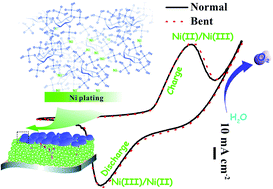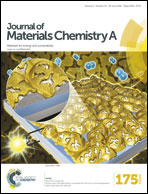Three-dimensional flexible electrode derived from low-cost nickel–phytate with improved electrochemical performance†
Abstract
We report a 3D flexible electrode, with a Cu nanowire array/polyimide membrane as the platform and nickel–phytate nanoplates as the electroactive material, used as an efficient water oxidation electrode and a favorable positive electrode for supercapacitors. The fabricated 3D electrode shows improved electrochemical performance, revealing the enhanced current density and ultra long-term electrochemical stability (7 days for electrocatalysis with 6% current density loss and 20 000 cycles for the galvanostatic charge–discharge measurements with 12% areal capacitance loss). With deep analysis, the crucial factors determining the great enhanced performance could be the outstanding electron transfer provided by the 3D-nanowires support, the large electrochemically active surface area (EASA) and the formation of NiOx species with a high oxidation state. Moreover, the growth mechanism of the Ni–phytate compounds is carefully investigated. Importantly, this green approach considered to be a corrosion-growth process is conducted under mild conditions and involves the application of phytic acid, abundant in living organisms, could have potential in future research.


 Please wait while we load your content...
Please wait while we load your content...